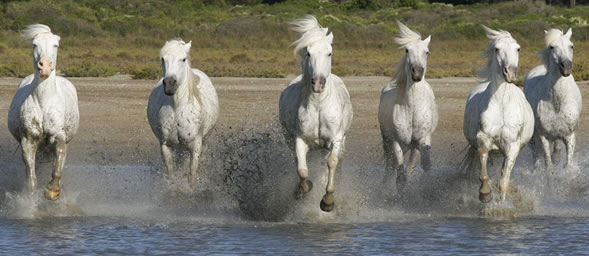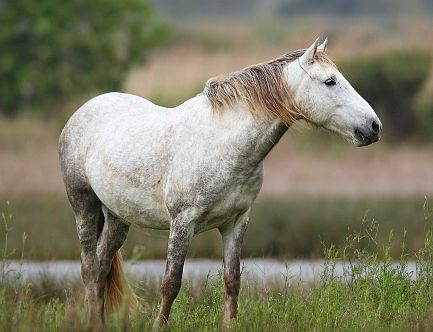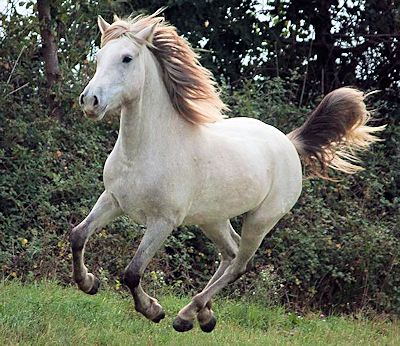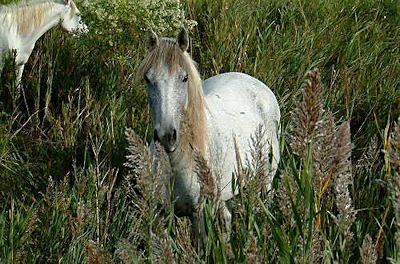The Camargue Pony lives in a harsh climate in the Rhone delta of southern France. They are able to survive on salty reeds and rough grass.

Origin: France. As the name suggests, these horses come from the Camargue, a wetland area at the mouth of the River Rhône. They constitute a distinct breed, which, like the Camargue bulls, live in semi-liberty.
They are bred in an area bounded by Montpellier to the west, Tarascon to the north and Fos to the east, passing through Salon-de-Provence, an area which encompasses the Ile de Camargue, the plains of the Gard and the Hérault, and part of the Crau.
Color: At birth they are colored dark brown or black, but turn white around the fourth year. (In layman’s terms they are white horses, but to horsy folk they are grey, since they are not uniformly pure white all over).
Height: At around thirteen or fourteen hands they are technically ponies.
 Conformation: Large, squarish head with a straight or slightly convex profile. The eyes are large and expressive and the ears are broad and short with a broad base.
Conformation: Large, squarish head with a straight or slightly convex profile. The eyes are large and expressive and the ears are broad and short with a broad base.
The neck is short and muscular, deep at the base, the withers are pronounced, the back is straight and short. The croup is short and narrow, the chest wide and deep.
The shoulder is rather straight and quite short; the mane and tail are long and thick. The legs are extremely hardy with clean joints, a long forearm, and very good hooves.
Character: Generally of good disposition.
Uses: The Camargue is a rugged horse that breeds true to type. They are lively but have a good nature and are particularly suited for riding. They have an even-temper but are lively, agile, brave and hardy. They will travel long distances with ease and are capable of enduring extreme weather and extended periods without food. Their broad hooves are evolutionary adaptions to their wet environment. Camargues are not shod.
Lifespan: 20-25 years.
 History: The existence of breed is very old. One school of thought states that these horses have been in existence since pre-historic times.
History: The existence of breed is very old. One school of thought states that these horses have been in existence since pre-historic times.
The Camargue horse is one of the oldest breeds in the world, closely related to the prehistoric horses whose remains have been found elsewhere in southern France.
The origins of this breed are not very well known. Many believe that these horses descended from an extinct horse called Soutre (dated to at least 17,000 years ago) that was found in the southeast region of France.
Horse images in Paleolithic cave paintings at Lascaux provide further evidence of Prehistoric horses in south-western France.
Celts, Franks, Romans, Greeks, Moors and many more people settled in this region of France and all the horses they brought along with them have played a part in the development of this breed. Today, however, this breed is well protected and cared for.
To preserve the purity of this breed, the French government set up the breed standards in 1976. In the year 1978, the first stud book was released for this breed.
 Riders are called gardians. Gardians are as near to anyone comes nowadays to living the cowboy way of life. They play a major role in guarding Camarguais traditions. They live in traditional cabanes, thatched and windowless single-storey structures furnished with bulls’ horns over the door to ward off evil spirits. A guardien’s traditional tools are a trident and a black hat.
Riders are called gardians. Gardians are as near to anyone comes nowadays to living the cowboy way of life. They play a major role in guarding Camarguais traditions. They live in traditional cabanes, thatched and windowless single-storey structures furnished with bulls’ horns over the door to ward off evil spirits. A guardien’s traditional tools are a trident and a black hat.
The gardians are people who are responsible for branding, annual inspection and gelding of stock that is not suitable.
Camargues are used to manage the bull herds. They also provide visitors with the opportunity to explore the Camargue region on horseback. Camargue horses thrive in Sea water – they are often called “the horse of the sea.”
In spring the Camargue horse grazes on new shoots of tall reeds, and on an indigenous plant called samphire. In winter they survive on dried grass and goosefoot, a plant too tough for most grazing animals. The horses’ behaviour is regulated by the amount of food available. When it is scarce the Camargue horse may graze for up to 22 hours a day. When it is plentiful, it will graze only at dawn and dusk.
Horses of the Camargue run wild – or at least semi-wild – in small herds consisting of one stallion, his mares and progeny. Fillies are usually caught and branded as yearlings and colts considered unsuitable for breeding are gelded at three years old. Breeding is semi-wild but under supervision of the Biological Research Station of la Tour du Valat. Scientists have been able to observe the social interactions and lifestyles of Camargue horses contributing to our understanding of equine behavior.
